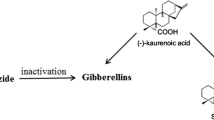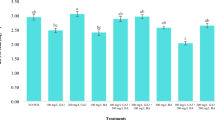Abstract
The stem growth in darkness or in continuous red light of two pea cultivars, Alaska (Le Le, tall) and Progress No. 9 (le le, dwarf), was measured for 13 d. The lengths of the first three internodes in dark-grown seedlings of the two cultivars were similar, substantiating previous literature reports that Progress No. 9 has a tall phenotype in the dark. The biological activity of gibberellin A20 (GA20), which is normally inactive in le le geno-types, was compared in darkness and in red light. Alaska seedlings, regardless of growing conditions, responded to GA20. Dark-grown seedlings of Progress No. 9 also responded to GA20, although red-light-grown seedlings did not. Gibberellin A1 was active in both cultivars, in both darkness and red light. The metabolism of [13C3H]GA20 has also been studied. In dark-grown shoots of Alaska and Progress No. 9 [13C3H]GA20 is converted to [13C3H]GA1, [13C3H]GA8, [13C]GA29, its 2α-epimer, and [13C3H]GA29-catabolite. [13C3H] Gibberellin A1 was a minor product which appeared to be rapidly turned over, so that in some feeds only its metabolite, [13C3H]GA8, was detected. However results do indicate that the tall growth habit of Progress No. 9 in the dark, and its ability to respond to GA20 in the dark may be related to its capacity to 3β-hydroxylate GA20 to give GA1. In red light the overall metabolism of [13C3H]GA20 was reduced in both cultivars. There is some evidence that 3β-hydroxylation of [13C3H]GA20 can occur in red light-grown Alaska seedlings, but no 3β-hydroxylated metabolites of [13C3H]GA20 were observed in red light-grown Progress. Thus the dwarf habit of Progress No. 9 in red light and its inability to respond to GA20 may be related, as in other dwarf genotypes, to its inability to 3β-hydroxylate GA20 to GA1. However identification and quantification of native GAs in both cultivars showed that red-light-grown Progress does contain native GA1. Thus the inability of red light-grown Progress No. 9 seedlings to respond to, and to 3β-hydroxylate, applied GA20 may be due to an effect of red light on uptake and compartmentation of GAs.
Similar content being viewed by others
Abbreviations
- AMO-1618:
-
2′-isopropyl-4′-(trimethylammonium chloride)-5′-methylphenyl piperidine-1-carboxylate
- cv.:
-
cultivar
- GC-MS:
-
gas chromatography-mass spectrometry
- GA(n) :
-
gibberellin A(n)
- HPLC:
-
high-pressure liquid chromatography
References
Arnon, D.I. (1938) Micro elements in culture-solution experiments with higher plants. Am. J. Bot. 25, 322–325
Beale, M.H., Gaskin, P., Kirkwood, P.S., MacMillan, J. (1980) Partial synthesis of gibberellin A9 and [3α and 3β-2H1]gibberellin A9; gibberellin A5 and [1β,3-2H2 and 3H2]gibberellin A5; and gibberellin A20 and [1β, 3α-2H2 and 3H2]gibberellin A20. J. Chem. Soc. Perkin I, 885–891
Boyer, C.D. (1981) Starch granule formation in developing seeds of Pisum sativum L.: effect of genotype. Am. J. Bot. 68, 659–665
Cooke, R.J., Saunders, P.F. (1975) Phytochrome-mediated changes in extractable gibberellin activity in a cell-free system from etiolated wheat leaves. Planta 123, 299–302
Ecklund, P.R., Moore, T.C. (1974) Correlations of growth rate and deetiolation with rate of ent-kaurene biosynthesis in pea (Pisum sativum L.). Plant Physiol. 53, 5–10
Evans, A., Smith, H. (1976) Localisation of phytochrome in etioplasts and its regulation in vitro of gibberellin levels. Proc. Natl. Acad. Sci. USA 73, 138–142
Gaskin, P., Gilmour, S.J., MacMillan, J., Sponsel, V.M. (1985) Gibberellins in immature seeds and dark-grown shoots of Pisum sativum. Gibberellins identified in the tall cultivar Alaska in comparison with those in the dwarf Progress No. 9. Planta 163, 283–289
Gorter, C.J. (1961) Dwarfism of peas and the action of gibberellic acid. Physiol. Plant. 14, 332–343
Hasegawa, K., Koreeda, M., Hase, T. (1983) A new growth inhibitor, pisumin, involved in light inhibition of epicotyl growth of dwarf peas. Plant Physiol. 72, 391–393
Ingram, T.J., Reid, J.B., Potts, W.C., Murfet, I.C. (1983) Internode length in Pisum. IV. The effect of the Le gene on gibberellin metabolism. Physiol. Plant. 59, 607–616
Ingram, T.J., Reid, J.B., Murfet, I.C., Gaskin, P., Willis, C.L., MacMillan, J. (1984) Internode length in Pisum. The Le gene controls the 3β-hydroxylation of gibberellin A20 to gibberellin A1. Planta 160, 455–463
Jones, J.F., Kende, H. (1979) Auxin-induced ethylene biosynthesis in subapical stem sections of etiolated seedlings of Pisum sativum L. Planta 146, 649–656
Jones, R.L., Lang, A. (1968) Extractable and diffusible gibberellins from light- and dark-grown pea seedlings. Plant Physiol. 43, 629–634
Kende, H., Lang, A. (1964) Gibberellins and light inhibition of stem growth in peas. Plant Physiol. 39, 435–440
Kirkwood, P.S., MacMillan, J., Beale, M.H. (1982) Partial synthesis of [17-13C; 15,17-3H]gibberellin A29 from gibberellin A3. J. Chem. Soc. Perkin I, 699–706
Komoto, N., Ikegami, S., Tamura, S. (1972a) Isolation of acidic growth inhibitors in dwarf peas. Agric. Biol. Chem. 36, 2547–2553
Komoto, N., Noma, M., Ikegami, S., Tamura, S. (1972b) Isolation of neutral growth inhibitors in dwarf peas. Agric. Biol. Chem. 36, 2555–2561
Leiberman, M., Knegt, E. (1977) Influence of ethylene on indole-3-acetic acid concentration in etiolated pea epicotyl tissue. Plant Physiol. 60, 475–477
Lockhart, J.A. (1956) Reversal of light inhibition of pea stem growth by gibberellins. Proc. Natl. Acad. Sci. USA 42, 841–848
Lockhart, J.A., Gottschall, V. (1959) Growth responses of Alaska pea seedlings to visible radiation and gibberellic acid. Plant Physiol. 34, 460–465
Matters, G.L., Boyer, C.D. (1982) Soluble starch synthases and starch binding enzymes from cotyledons of smooth and wrinkled seeded lines of Pisum sativum. L. Biochem. Genet. 20, 833–848
McComb, A.J., McComb, J.A. (1970) Growth substances and the relation between phenotype and genotype in Pisum sativum. Planta 91, 235–245
Mohr, H., Pinnig, E. (1962) Der Einfluss des Lichtes auf die Bildung von Blattprimordien am Vegetationskegel der Keimlinge von Sinapsis alba L. Planta 58, 569–579
Musgrave, A., Kende, H. (1970) Radioactive gibberellin A5 and its metabolism in dwarf peas. Plant Physiol. 45, 56–61
Potts, W.C., Reid, J.B., Murfet, I.C. (1982) Internode length in Pisum. I. The effect of the Le/le gene difference on endogenous gibberellin-like substances. Physiol. Plant. 55, 323–328
Railton, I.D. (1974) Studies on gibberellins in shoots of light-grown peas. II. The metabolism of tritiated gibberellin A9 and gibberellin A20 by light- and dark-grown shoots of dwarf Pisum sativum var. Meteor. Plant Sci. Lett. 3, 207–212
Reid, J.B. (1983) Internode length in Pisum. Do the internode length genes effect growth in dark-grown plants? Plant Physiol. 72, 759–763
Russell, D.W., Galston, A.W. (1968) Comparative analysis of phytochrome-mediated growth responses in internodes of dwarf and tall pea plants. Planta 78, 1–10
Sembdner, G., Gross, D., Liebisch, H.-W., Schneider, G. (1980) Biosynthesis and metabolism of plant hormones. In: Encyclopedia of plant physiology, N.S., vol. 9: Hormonal regulation of development, I, pp. 281–444, MacMillan, J. ed., Springer, Berlin Heidelberg New York
Smith, H. (1975) Phytochrome and photo-morphogenesis. McGraw Hill, London
Simpson, G.M., Saunders, P.F. (1972) Abscisic acid associated with wilting in dwarf and tall Pisum sativum. Planta 102, 272–276
Sponsel, V.M. (1983) The localization, metabolism and biological activity of gibberellins in maturing and germinating seeds of Pisum sativum cv. Progress No. 9. Planta 159, 454–468
Sponsel, V.M., MacMillan, J. (1978) Metabolism of gibberellin A29 in seeds of Pisum sativum cv. Progress No. 9; use of [2H] and [3H]GAs, and the identification of a new GA catabolite. Planta 144, 69–78
Author information
Authors and Affiliations
Rights and permissions
About this article
Cite this article
Sponsel, V.M. Gibberellins in dark- and red-light-grown shoots of dwarf and tall cultivars of Pisum sativum: The quantification, metabolism and biological activity of gibberellins in Progress no. 9 and Alaska. Planta 168, 119–129 (1986). https://doi.org/10.1007/BF00407018
Received:
Accepted:
Issue Date:
DOI: https://doi.org/10.1007/BF00407018




